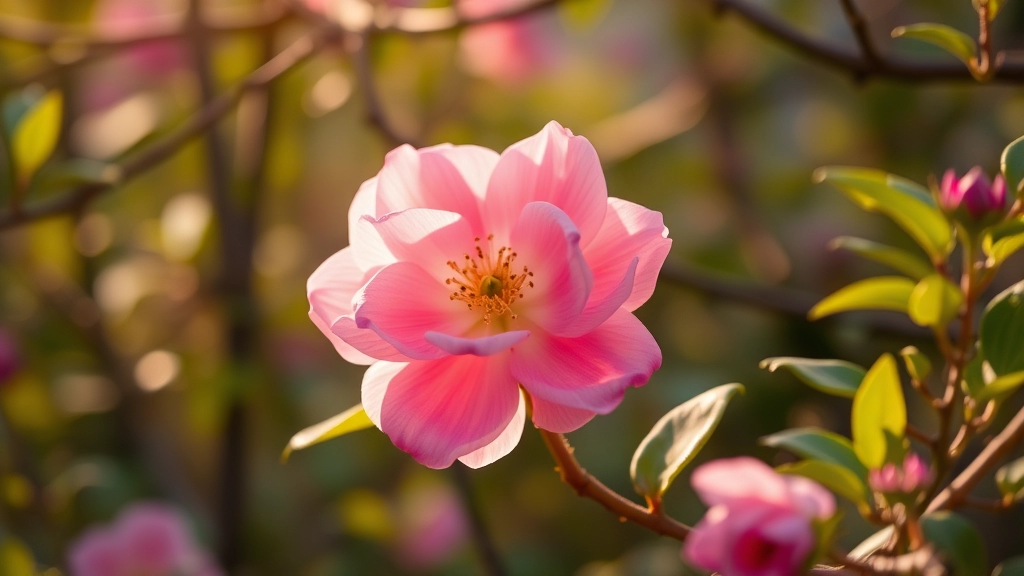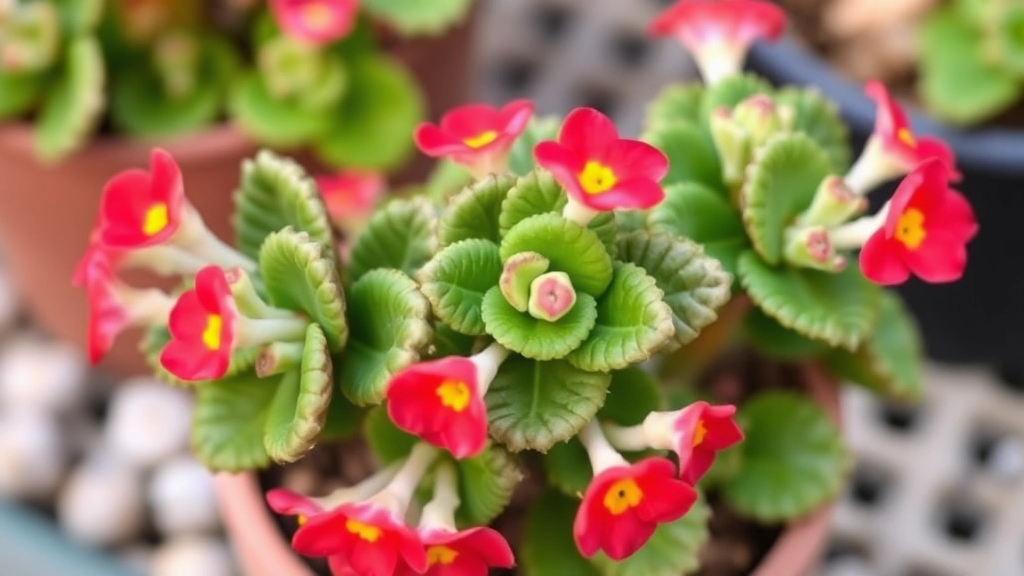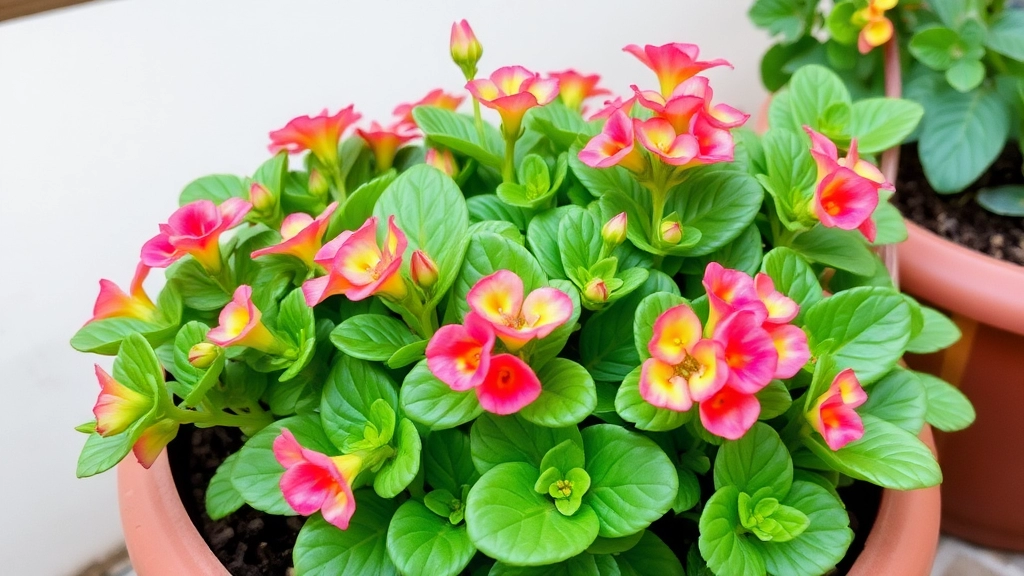Why Your Florist Kalanchoe Isn’t Flowering
Ever wondered why your Florist Kalanchoe is not flowering? You’re not alone. Many plant enthusiasts face this issue and it’s often due to a few common factors. Understanding the causes is the first step to getting those beautiful blooms back. Let’s dive into what might be going wrong and how you can fix it.
Key Factors Affecting Blooming
- Light Conditions: Light conditions play a crucial role in the blooming of your Kalanchoe. Ensure your plant gets plenty of indirect sunlight.
- Watering and Fertilization: Overwatering or improper fertilization can also stress the plant, hindering its ability to flower.
- Dormancy Period: Don’t forget, Kalanchoes need a dormancy period to reset and prepare for the next blooming cycle.
- Pruning: Proper pruning and keeping an eye out for pests and diseases will also help your plant thrive.
Let’s get your Florist Kalanchoe back to its flowering glory!
Have you ever wondered why your beautiful Kalanchoe isn’t blooming despite your best efforts?
Understanding the reasons behind this issue can save you time and frustration.
Here are some common causes that might be preventing your Kalanchoe from producing those vibrant flowers:
### 1. Insufficient Light
Kalanchoes thrive in bright, indirect light.
If they don’t receive enough, they may produce lush foliage but few or no blooms.
### 2. Overwatering
While Kalanchoes need moisture, overwatering can lead to root rot.
This condition can severely affect their ability to flower.
### 3. Improper Temperature
Kalanchoes prefer temperatures between 15°C and 25°C.
Extreme heat or cold can stress the plant, inhibiting flowering.
### 4. Lack of Nutrients
Using the wrong type of fertiliser or not fertilising at all can result in poor blooming.
Kalanchoes benefit from a balanced fertiliser during their growing season.
### 5. Age of the Plant
Older Kalanchoes may naturally bloom less as they age.
If your plant is several years old, it might just be time for a refresh. For more detailed care tips, you can check out this [complete guide for Kalanchoe Beharensis Variegated](https://planthq.org/complete-care-guide-for-kalanchoe-beharensis-variegated/) or explore different [flowering Kalanchoe species and care tips](https://planthq.org/top-flowering-kalanchoe-species-and-care-tips/).
Adjusting Light Conditions to Encourage Blooming

So, you’ve got your beautiful Kalanchoe, but it just won’t bloom. Frustrating, right? One of the biggest culprits could be the light conditions. Let’s dive into how adjusting the light can spark those blooms.
Understanding Light Needs
Kalanchoe loves bright, indirect sunlight. Too little light? That’s a recipe for disappointment. Too much direct sun? You might end up with scorched leaves.
- Location: Place your Kalanchoe near a window that gets plenty of light but isn’t blasting it all day long. East or west-facing windows work wonders.
- Duration: Aim for around 12-14 hours of light a day. If natural light is lacking, consider using grow lights. They can make a huge difference!
- Rotation: Every couple of weeks, give your plant a gentle turn. This helps all sides get equal light and encourages even growth.
Signs of Light Stress
Keep an eye out for these signs to know if your Kalanchoe is getting the right amount of light:
- Leggy Growth: Stretched-out stems mean it’s reaching for more light.
- Yellowing Leaves: This could indicate too much direct sunlight.
- Slow Growth: If it seems to be standing still, it might be time to adjust its light exposure.
Seasonal Adjustments
As the seasons change, so should your plant’s light exposure.
- Winter: Days are shorter, so move it closer to the window.
- Summer: If it’s getting too hot, provide some shade during peak hours.
By fine-tuning the light conditions, you’ll be well on your way to coaxing those blooms out of your Kalanchoe.
Proper Watering and Fertilization Techniques
One of the most common concerns for Kalanchoe owners is ensuring their plants bloom beautifully. The right watering and fertilization techniques play a crucial role in this process.
Watering Guidelines
Kalanchoe plants thrive in well-draining soil, and overwatering can lead to root rot, which stifles blooming. Here are some key tips to keep in mind:
- Watering Frequency: Allow the top inch of soil to dry out before watering again. This typically means watering every 2-3 weeks, depending on your environment.
- Watering Method: Water deeply, ensuring that excess water drains out of the pot. Avoid letting the plant sit in water.
- Signs of Overwatering: Yellowing leaves and a mushy stem indicate too much water. Adjust your watering schedule accordingly.
Fertilization Tips
Feeding your Kalanchoe correctly can stimulate flowering. Here’s how to do it effectively:
- Type of Fertilizer: Use a balanced, water-soluble fertiliser with equal parts nitrogen, phosphorus, and potassium. Look for a ratio like 10-10-10.
- Frequency: Fertilize every 4-6 weeks during the growing season (spring and summer). Reduce or stop fertilising during the dormant period (autumn and winter).
- Dilution: Always dilute the fertiliser to half the recommended strength to avoid burning the roots.
Real-Life Example
I once had a Kalanchoe that refused to bloom. After adjusting my watering schedule and introducing a diluted fertiliser, it transformed into a vibrant display of flowers. For more detailed care instructions, you might find our expert tips on Kalanchoe care helpful. Additionally, if you’re interested in different varieties, check out our guide on top Kalanchoe succulent varieties.
How Dormancy Periods Affect Kalanchoe Flowering

Have you ever noticed your Kalanchoe suddenly stopping its vibrant display of flowers? It can be disheartening, especially when you’ve put in the effort to care for it. One key factor that can affect flowering is the plant’s dormancy period.
Understanding Dormancy
Dormancy is a natural phase in a Kalanchoe’s life cycle, often occurring after the flowering season. During this time, the plant conserves energy and resources, which may lead to a temporary halt in blooming.
Key Points to Consider:
- Timing: Dormancy typically occurs in late autumn to winter.
- Duration: This period can last several weeks to a few months, depending on environmental conditions.
- Signs: Look for reduced growth and fewer flowers during dormancy.
Impact on Flowering
The dormancy period is crucial for Kalanchoe as it allows the plant to recover and prepare for the next blooming cycle. Here’s how it influences flowering:
- Energy Conservation: The plant focuses on storing energy, which is essential for future blooms.
- Stress Recovery: It helps the plant recover from stress factors like overwatering or insufficient light.
- Flower Bud Formation: After dormancy, the plant is better equipped to produce flower buds when conditions improve.
Encouraging Post-Dormancy Blooming
To ensure your Kalanchoe blooms beautifully after its dormancy, consider the following steps:
- Gradual Reintroduction of Light: Slowly increase light exposure to stimulate growth.
- Moderate Watering: Resume watering carefully to avoid shock.
- Fertilization: Use a balanced fertilizer to support new growth.
Pruning is a vital part of plant care that can significantly encourage flowering. If you’ve been nurturing your Kalanchoe but find it still isn’t blooming, consider the impact of pruning.
Pruning helps to remove dead or excess foliage, allowing the plant to focus its energy on producing flowers. It also promotes better air circulation and light penetration, which are essential for healthy growth.
The best time to prune your Kalanchoe is right after it has finished blooming. This timing allows the plant to recover and prepare for the next blooming cycle. For regular maintenance, keep an eye on your plant throughout the year. Removing any dead or yellowing leaves as they appear can help maintain its overall health.
Ensure your scissors or pruning shears are clean to prevent disease. Always cut just above a leaf node to encourage new growth in the right direction. Snip off any dead flowers to redirect energy towards new buds and trim back overly leggy or unruly stems to encourage a fuller shape.
For more detailed care tips, you can refer to the [care guide for flowering Kalanchoe](https://planthq.org/care-guide-for-flowering-kalanchoe-2030cm-tall-blossfeldiana/). Additionally, understanding the [optimal care for Kalanchoe Blossfeldiana growth](https://planthq.org/optimal-care-for-kalanchoe-blossfeldiana-growth/) can further enhance your plant’s health and blooming potential.
By incorporating these pruning methods, you can significantly enhance your Kalanchoe’s chances of blooming beautifully.
Troubleshooting Pests and Diseases that Hinder Blooming
Have you noticed your Kalanchoe struggling to bloom despite your best efforts?
Pests and diseases can be sneaky little culprits that ruin your plant’s chances of flowering.
Here’s how to spot them and what you can do about it.
Common Pests to Watch For:
- Mealybugs: These fuzzy little critters love to hide in the leaf joints. Look for white, cotton-like spots.
- Spider Mites: Tiny and tricky, these pests create fine webbing. If your leaves look dusty, you might have a problem.
- Aphids: These small green or black bugs suck the sap from your plant, leading to wilting.
Signs of Disease:
- Root Rot: If your plant’s leaves are yellowing and mushy, it could be drowning. Check the soil moisture!
- Powdery Mildew: A white, powdery substance on leaves is a sign of fungal infection. It thrives in humid conditions.
Steps to Combat Pests and Diseases:
- Inspect Regularly: Check your Kalanchoe weekly. Early detection is key!
- Natural Remedies:
- Neem Oil: A great natural pesticide. Mix it with water and spray on affected areas.
- Insecticidal Soap: Effective against many pests, just make sure to cover all surfaces.
- Cleanliness Matters: Wipe down leaves with a damp cloth to remove dust and pests.
- Good Drainage: Ensure your pot has drainage holes and avoid overwatering to prevent root rot.
- Quarantine Affected Plants: If you spot pests, isolate the plant to prevent spreading.
For more tips on keeping your Kalanchoe healthy, check out our guide to maximizing Kalanchoe plant longevity and our leaf care tips and troubleshooting for Kalanchoe Blossfeldiana.
FAQs About Florist Kalanchoe Not Flowering
Why is my Kalanchoe not flowering?
The primary reasons your Kalanchoe may not be flowering include inadequate light conditions, improper care during dormancy, and insufficient light exposure. Adjusting these factors can help encourage blooming.
What kind of light does a Kalanchoe need to bloom?
Kalanchoe thrives in bright, indirect sunlight. Aim for around 12-14 hours of light daily. If natural light is insufficient, consider using grow lights to supplement.
How can I tell if my Kalanchoe is getting too much or too little light?
Signs of light stress include leggy growth (indicating too little light), yellowing leaves (too much direct sunlight), and slow growth. Adjust the light exposure based on these signs.
What should I do if my Kalanchoe is in its dormancy period?
During dormancy, which typically occurs from late autumn to winter, the plant conserves energy and may stop blooming. Allow it to rest, and reduce watering. After dormancy, gradually reintroduce light and resume regular care to encourage blooming.
How long does the dormancy period last for a Kalanchoe?
The dormancy period can last several weeks to a few months, depending on environmental conditions. During this time, expect reduced growth and fewer flowers.
What are the signs that my Kalanchoe is in dormancy?
Signs of dormancy include reduced growth and fewer flowers. The plant may also focus on storing energy and recovering from stress factors.
How can I encourage my Kalanchoe to bloom after dormancy?
To encourage blooming after dormancy, gradually increase light exposure, resume moderate watering, and use a balanced fertilizer to support new growth.
Can seasonal changes affect my Kalanchoe’s blooming cycle?
Yes, seasonal changes can impact light exposure and temperature, affecting the blooming cycle. In winter, move the plant closer to a light source, and in summer, provide shade during peak sunlight hours.
What are the best locations for placing my Kalanchoe indoors?
Place your Kalanchoe near east or west-facing windows that receive plenty of indirect sunlight. Avoid locations with direct, harsh sunlight to prevent leaf scorching.
Should I rotate my Kalanchoe to ensure even growth?
Yes, rotating your Kalanchoe every couple of weeks helps all sides receive equal light, promoting even growth and encouraging blooming.
References
-
Kalanchoe Light Requirements
-
Kalanchoe Plant Profile
-
How to Grow and Care for Kalanchoe
